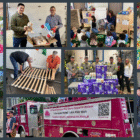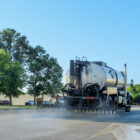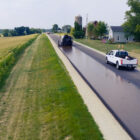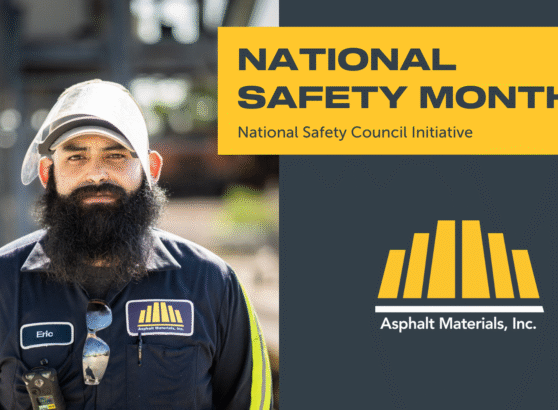National Safety Month is held every June to help reduce workplace injuries and deaths in the United States. In 1996, the National Safety Council designated June as National Safety Month. This year marks 28 years of safety awareness brought by thousands of companies worldwide. Safety is apart of everything we do here at AMI, therefore it is an integral campaign for our company.

This year Asphalt Materials will be focusing on four key areas of safety, spreading a weekly safety message including: safety engagement, roadway safety, risk reduction and slips, trips and falls.
While we talk about these subjects and know safety is first year-round, join us this month as we bring an elevated effort throughout our social media and communication platforms.
Safety Engagement
Safety engagement starts with communication. Research shows that companies that communicate effectively are 4x times as likely to report high levels of employee engagement. Most importantly, high engaged employees are less likely to have an accident or get injured on the job. One way to engage employees is to regularly give feedback and recognition for their safety efforts. 43% of high engaged employees receive feedback at least once a week, compared to 18% with low engagement.
The first week of June is also National CPR and AED Awareness Week. When an emergency arises, knowing CPR and how to use an AED can save lives. View this survivor video and learn more about NSC First Aid training.
Roadway Safety

In 2023, 44,450 people died in motor vehicle crashes according to the National Safety Council estimates. Being aware of your surroundings and understanding how to share the roads safely with others improves your chances of avoiding potentially deadly situations.
Check out this 5-minute toolbox talk by the National Safety Council to learn how to safely navigate the roads.
Risk Reduction
Working together, we can be one of our best defenses. Hazard reporting is a critical part of safety programs. Whether it is telling your supervisor, maintenance team, safety committee or sharing in a designated reporting system, it is best to report hazards as soon as they are noticed. Do not assume that someone else has seen and reported it already, even if it seems obvious to you. It is better to have multiple reports on the same hazard than none. You are the expert in your job, your workstation, your routines, and tools. If you notice something out of the ordinary, you should feel empowered to say something about it. Also, be sure to avoid the trap of complacency – when you have done something a thousand times it can be difficult to spot a lurking hazard.

Slips, Trips and Falls
According to Injury Facts, falls to the same level are a leading cause of preventable workplace injuries causing time away from work. While walking seems like a simple task, it has been a leading cause of workplace injury for many years. Employees need to watch out for all the hazards tied to walking just as they would in any other part of our job that poses a safety risk. So, what are some of the dangers tied to walking? They include distraction, footwear, poor walking surfaces, damaged surfaces and basic housekeeping.
Check out this 5-minute toolbox talk to prevent slips, trips and falls.

If you ever have questions about safety procedures, reach out to your local safety representative. Thank you for your commitment to working the safe way.





Recent Comments